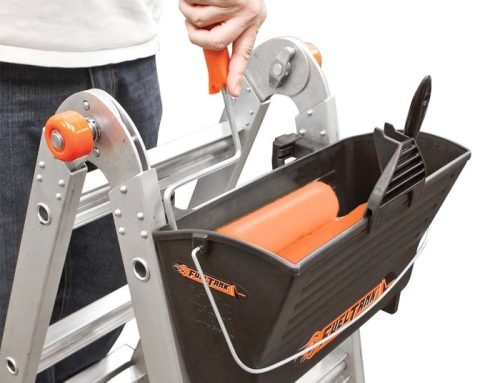Finding yourself half way up an extension ladder when it begins to slide or wobble beneath you can be a heart-stopping experience. If you have ever been there, I'm sure you would agree with us when we say we would never want to be in that position again. In this post we are going to share some essential safety tips when working on an extension ladder. We hope this article helps stop any accidents or incidents that could occur when working at height. If you are not sure whether you are working on an extension ladder or another type of ladder; you can define an extension ladder by their noticeable two sections. These operate in brackets or guides, allowing for adjustable length. So here goes, to stay safe please bear in mind our following tips:
The Angle Making sure the extension ladder is set at the correct angle is key to its safe operation. This may seem like a complicated task but there is in fact a very easy way to check this. Simply place your toes against the feet of the ladder, stand up straight and extend your arms in front of you to reach out for the ladder and you should be able to place the palms of your hands on the rung. If you set up the extension ladder too steep, it could result in the ladder tipping over backwards. Not something you want to happen. Alternatively, if the ladder is placed against a structure with the legs too far away, creating a more gradual incline, the ladder may buckle or the bottom could slide out and entirely slip away from the structure. Again, not something you want to happen.
Feet Security Depending on the ground beneath the extension ladder, there are different safety measures that can be taken to prevent slipping. On soft ground, the shoes of the ladder can be flipped over and the spurs dug into the ground. However, if the ground is too hard to secure the ladder in this way, an alternative is to screw down a cleat to prevent movement. As an additional safety measure, ropes can be tied to both ladder legs below the bottom rung and secured to an anchor point. This may seem like unnecessary work, but trust us when we say it would be a lot more inconvenient if you have a ladder related accident or incident. Top Knot To stay safe at height, it is a good practice to tie off the top of the extension ladder by attaching it to a solid anchor point. Securing the top of the ladder is particularly important if you intend to make several trips up and down whilst the ladder is in the same location or if you plan to step off the ladder onto an adjacent platform, such as a roof, as this could cause the ladder to slide away sideways.
Height and Load Limitations Never attempt to exceed the ladder's length by tying two ladders together or over extending it. This may seem fairly obvious, but we have seen and heard all sorts of stories. When using an extension ladder, it is imperative that an overlap of at least three rungs is maintained to achieve stability and safe use. Equally important is proper load capacity. Ladders are categorised with duty ratings so that you can choose the right tool for the job. By overloading a ladder which has been designed to withstand only light duty weight, it may become unstable and result in an accident. As mentioned, we really hope this article helps prevent any ladder related accidents.






Leave A Comment
You must be logged in to post a comment.